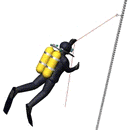I want to share my story with you so you can give me some recommendations:
This last weekend I conducted a dive to 166' deep that required a 14 minutes deco stop at 20' (last stop) using 99% O2 (Buhlmann GF 30/80). The waves were around 2-3 feet and a strong current was present.
I had planned to grab the line from the wreck to the vessel in the surface. When I reached the 20' mark, I thought I had adjusted my buoyancy when I started switching to the last deco bottle (100% O2)%, then I realized my computer was flashing (red numbers); I was going to the surface!
In the rush of finding the air deflator, I started blowing out all the air in my lungs; but, it was too late, I had my head above the water!
I never entered in panic; but, I thought I might pass out at any moment. I did not feel any symptom in the 1 second it took me to decide to go down again and restart the deco process at 40'.
When I completed the stops and got back in the boat, I tried to understand what happened with other divers. Someone said:"the line lost tension", that I had, probably, more air than necessary in my wing, "that is why I don't grab the lines, etc."
As of today (+48 hours later), I have no signs of bends; what bothers me is, what should be the best way to complete deco stops at 20' when waves and currents are present (deploying the safety sausage to stabilize, swing around all the time? What about doing the last deco stop at 25'-30'? I am not used to do decompression stops in open water but in caves, again, your advises are welcome.





